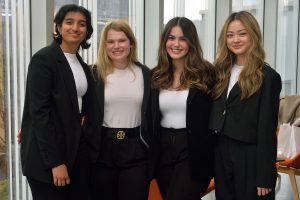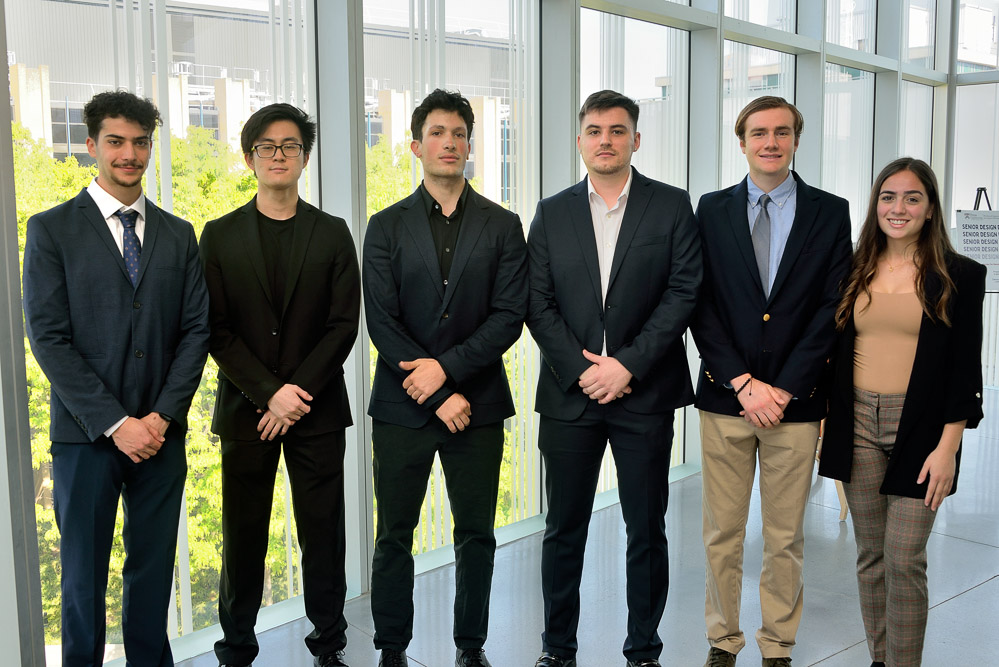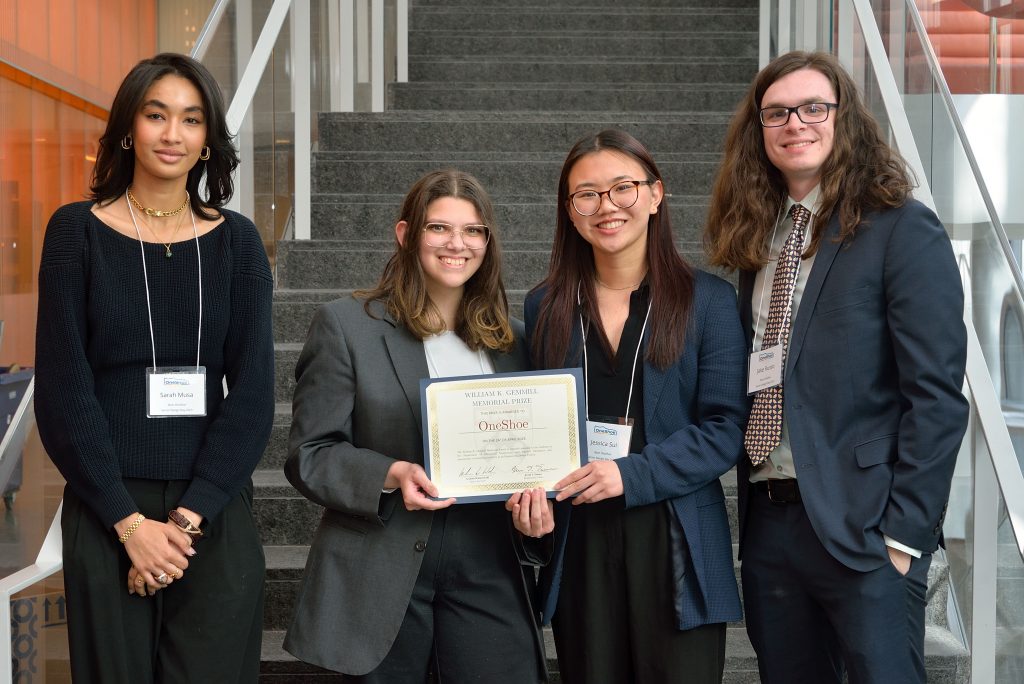Senior Design Competition
As the capstone of Penn’s practice-integrated mechanical engineering curriculum, the two-semester senior design sequence challenges students to bring theory, skills, general knowledge, and inventive energy to bear on substantial engineering problems. There is no “typical” project and the variety is always surprising: some projects lead to marketable products; some explore a theoretical principle; some are just for fun. But taken together, they reflect the breadth and diversity of mechanical engineering.
Information on this year’s teams can be found here. Information on the school-wide competition can be found here. Other MEAM undergraduate awards can be viewed here.
2025 Winners:
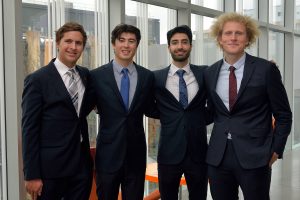
Team Helium Solutions, comprised of Ali Al Ayssami, Harrison Azrak, John Michael Hatheway, and Samuel Sullivan, were winners of the of the Judges’ Choice Award for excellence based on the discretion of the judges.
Current helium-filled soap bubble (HFSB) machines used for particle tracking velocimetry (PTV) are optimized for lab use, leaving a gap in the market for field-capable HFSB generators. Current lab HFSB machines are not designed for transportation and quick setup in the field, nor are the bubbles large enough for large-scale tests. The machine fills this gap by integrating all subcomponents into a portable system. Further, the bubbles generated are enlarged, improving tracking and scaling up the experimental volume on the order of 100 cubic meters.
Helium Solutions enables, for the first time, researchers and engineers to test full-scale or near-scale aerodynamics in their field environments, able to be transported easily in a passenger car. By leveraging resin 3D printing and designing for modularity, the system can be easily modified and repaired in the field in less than 30 minutes for setup and 15 minutes for changes. Manual controls enable the user to easily adjust gas ratios while local data recording creates a library of viable settings that accumulate over time.
Team Flash, comprised of Camila Pazos, Clarice Pranyoto, Ainsley Rexford, and Maya Shroff were winners of the William K. Gemmill Memorial Prize for outstanding creativity.
Developing film is costly, time intensive, and hard to master. If film is not developed correctly, the film is ruined forever and the precious memories captured in the photographs are lost. Film development involves technical processes that are hard to learn and require expensive equipment, costing users anywhere from $500 to $3,000. Current solutions attempt to simplify certain steps of the film development process but do not automate the entire process like Flash does. Flash works by taking in a user’s film canister and automatically reeling the film; a novel process that does not exist in the market. Then, Flash dunks the film reel in the properly heated chemical baths, returning the developed film to the user in less than 30 minutes.
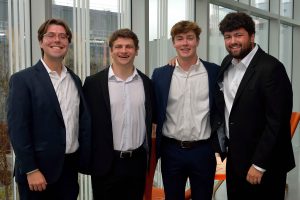
Team Velox, comprised of Tyler Chaudhary, John Fera, Ryan Kagarise, and Thomas Rebstock, were winners of the Francis G. Tatnall Prize for an outstanding project showing ingenuity, proficiency and usefulness.
As the world shifts away from fossil-fuel powered vehicles, environmentally friendly electric bikes grow increasingly popular, especially in inner cities where traffic and congestion are a major concern for commuters. However, these e-bikes often cost more than four figures, are bulky, and lack the ideal range of 15 miles for urban consumers on a budget with limited storage space. Velox provides a cheap, easy-to-install alternative to electric bikes in the form of an electric bike converter kit. This kit is perfect for bike riders who want the perks of riding an electric bike without spending over $1,000.
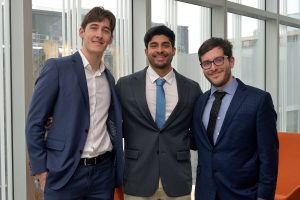
Team Robopicker, comprised of Rohan Maliekkal, Finn Maniscalco, and Eli Katz were winners of the John Couloucoundis Prize for the best senior design presentation.
Manual labor remains a cornerstone of the stone fruit industry, particularly in peach harvesting. However, reliance on human pickers poses challenges, including inefficiency, inconsistent ripeness assessments, and fruit damage during collection. These issues result in significant yield losses—up to 40%—reducing profits and raising prices. Stakeholders, such as farmers, have expressed the need for a solution to decrease yield loss without replacing workers.
The proposed solution is a handheld, pneumatic robotic fruit picker tool designed for peaches. The device integrates a cloud-based, offboard computer vision ripeness detection system with a lightweight peach gripper and onboard display, ensuring higher-quality, undamaged fruit is picked. This system reduces yield loss while maintaining the industry-standard picking rate of six peaches per minute. Its affordability (<$750) and ease of use (<2 hours training) make it accessible to large and small-scale operators.
Past Competitions:
2024 Winners
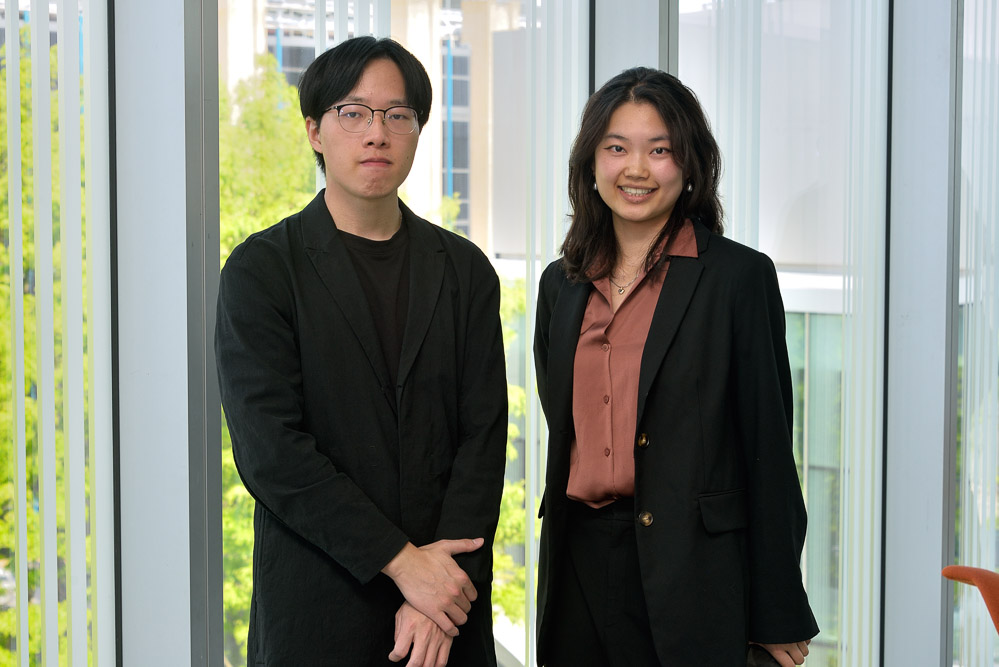
Team ShatterSweep, comprised of Ling Xu and Ming Zou, were winners of the of the Judges’ Choice Award for excellence based on the discretion of the judges.
North Philadelphia neighborhoods are plagued with illegal dumping issues, and efforts to clean up trash on the sidewalks pose safety hazards to workers due to the presence of sharp objects. This sharp object sweeper aims to sweep up small sharp pieces such as glass in North Philadelphia residential communities in partnership with North10 Philadelphia, a community service organization.
Currently, the North10 team managing waste piling on North Philadelphia streets consists of four workers who manually pick up and dispose of trash with minimal protective gear. The sharp object sweeper reduces physical exertion as well as contact with sharp objects to increase speed and safety of sharp waste collection and disposal. The final form is a sweeper integrated with a custom glass-breaking system similar to the size of a small lawnmower. Workers can push this sweeper to effectively collect sharp waste of varying sizes, remove the container in the back to dispose sharps safely, and fold up the sweeper to compactly store in their trucks to transport between sites.
Team Spotter Pro, comprised of Teddy Constan, Alex LaBarca, Troy Hill, Krystian Kresso, Ahmed Laban, Eric Gao were winners of the William K. Gemmill Memorial Prize for outstanding creativity.
Spotter Pro revolutionizes weightlifting through an integrated system of fitness devices engineered to optimize performance, prevent injury, and provide comprehensive feedback. Combining a sensor-equipped barbell clamp and shoe inserts with a user-friendly mobile application, where the ecosystem of devices addresses the challenge of inaccessible and inefficient workout tracking, offering an unparalleled lifting experience.
Spotter Pro delivers real-time feedback on key metrics such as bar path, lifting velocity, and force distribution while offering automated repetition tracking to make recording workouts easier and more efficient. Users can refine their technique for specific exercises through Spotter Pro’s form suggestions and personalized workout plans, ensuring they get the most out of their workouts while simultaneously minimizing the risk of injury. Our system will cost less than two hundred dollars and will be small enough to fit into a standard gym bag. Additionally, a battery life of at most four hours along with a Bluetooth range of up to ten feet allow for efficient, carefree use.
Spotter Pro effectively bridges the gap between elite training programs and everyday gym-goers. Our system sets a new standard in weightlifting technology, offering enhanced performance and reduced injury risks for all stakeholders. Through rigorous engineering standards and collaborative efforts, our system promises to redefine strength training while holding affordability, safety, and efficiency paramount.
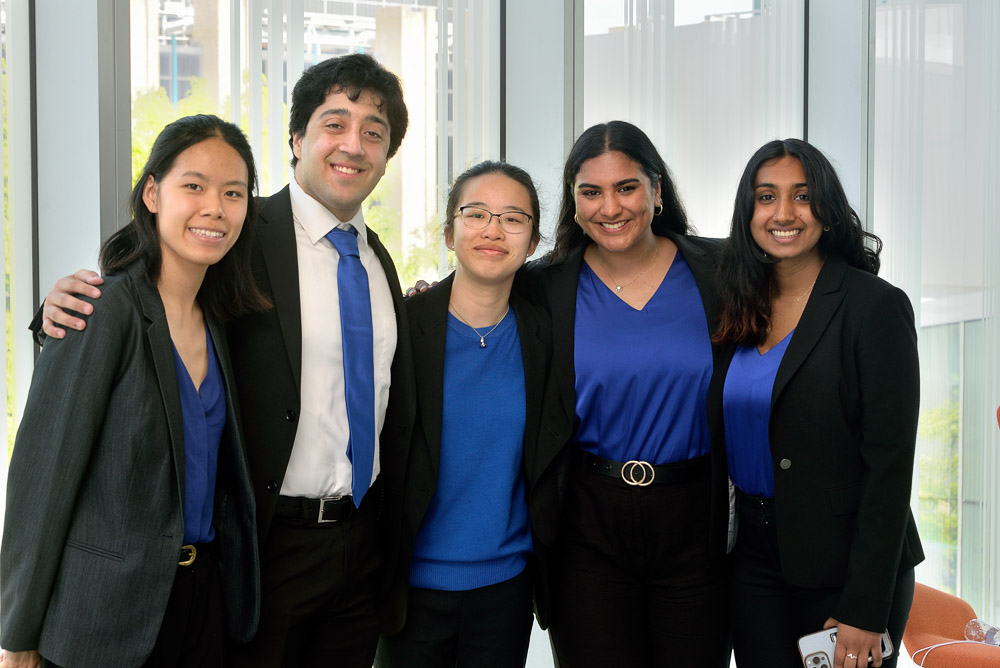
Team Crackle, comprised of Aditi Chintapalli, Runing Guan, Mei Han, Ilia Kheirkhah, and Shalika Neelaveni, were winners of the Francis G. Tatnall Prize for an outstanding project showing ingenuity, proficiency and usefulness.
Airport runways are subject to deterioration, resulting in cracks caused by fatigue and environmental factors. This necessitates frequent and efficient maintenance, given that unrepaired cracks steadily expand, undermining the structural integrity of runways and significantly escalating repair costs over time. Currently, crack sealing is dominated by manual repair techniques. Manual methods are labor-intensive and result in operational disruptions due to prolonged runway closures. Additionally, manual crack sealing poses safety risks to the maintenance crew who are exposed to toxic sealant fumes.
Crackle provides a safer and more streamlined approach to runway maintenance, catering to airport administrations and maintenance contractors. Our solution integrates a sealant heating and deposition system with state of the art computer vision and sensing into a fully autonomous robot that is ready to deploy on any runway. In the context of the United States, where approximately $2 billion is spent annually on runway maintenance, Crackle is poised to deliver significant cost savings and enhanced operational efficiency, while ensuring worker safety by reducing their exposure to hazardous environments.
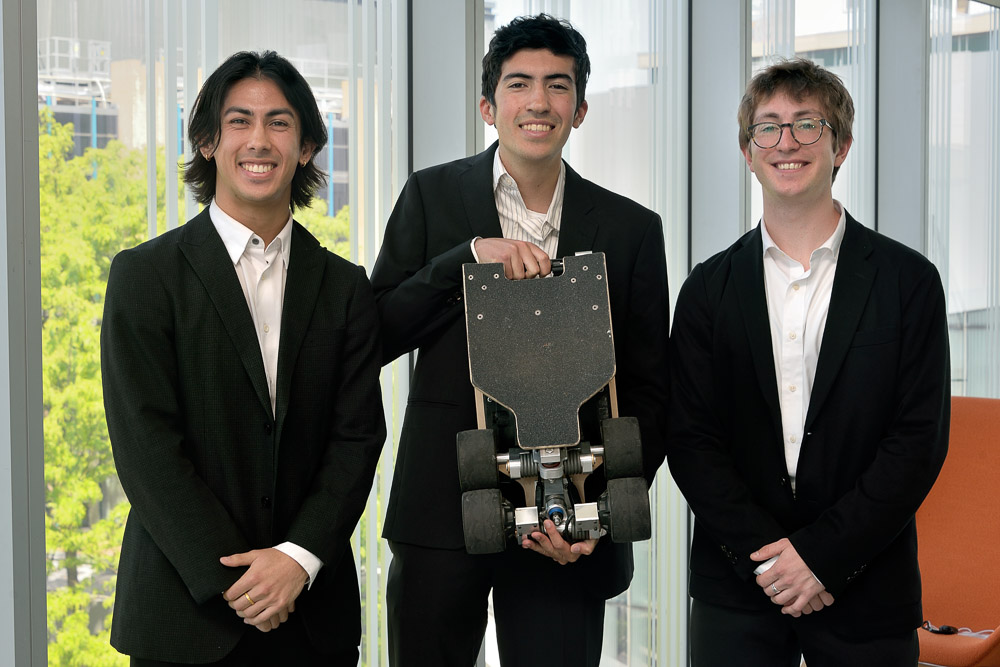
Team MorphBoard, comprised of Daniel Izmirian, Anton Ludwig, and Zachary Masotto were winners of the John Couloucoundis Prize for the best senior design presentation.
The global value of the micro-mobility industry is expected to double by 2030 to a total value of $440 billion. As this industry grows, there is increasing demand for a city-optimized personal transportation solution that combines the benefits of both stability and portability. Existing solutions fail to achieve a useful level of portability for the on-the-go travel required by college students and young professionals. Products in the market such as E-bikes and electric scooters are capable of traversing most obstacles encountered in urban commutes, but their inability to be easily stored between uses or to be transported easily by foot excludes a large segment of potential users. Morphboard provides a convenient solution with a small form factor that does not sacrifice the ride quality demanded by stakeholders.
Morphboard is a foldable, electric skateboard with an integrated suspension system to allow it to tackle obstacles encountered in cities such as trolley lines, curbs, or sidewalk cracks. Morphboard can be separated into three different subsystems: powertrain, suspension, and the deck. The powertrain is composed of in-hub motors capable of a 28 mph top speed and a battery pack with up to 11 miles of range. Morphboard uses an elegant torsion spring suspension integrated with a truck steering system to provide a compact shock reduction mechanism capable of smoothing out obstacles encountered during urban commutes. The board deck folds in half to reduce storage volume by nearly 50%, and allows for easy carrying with an integrated handle.
2023 Winners
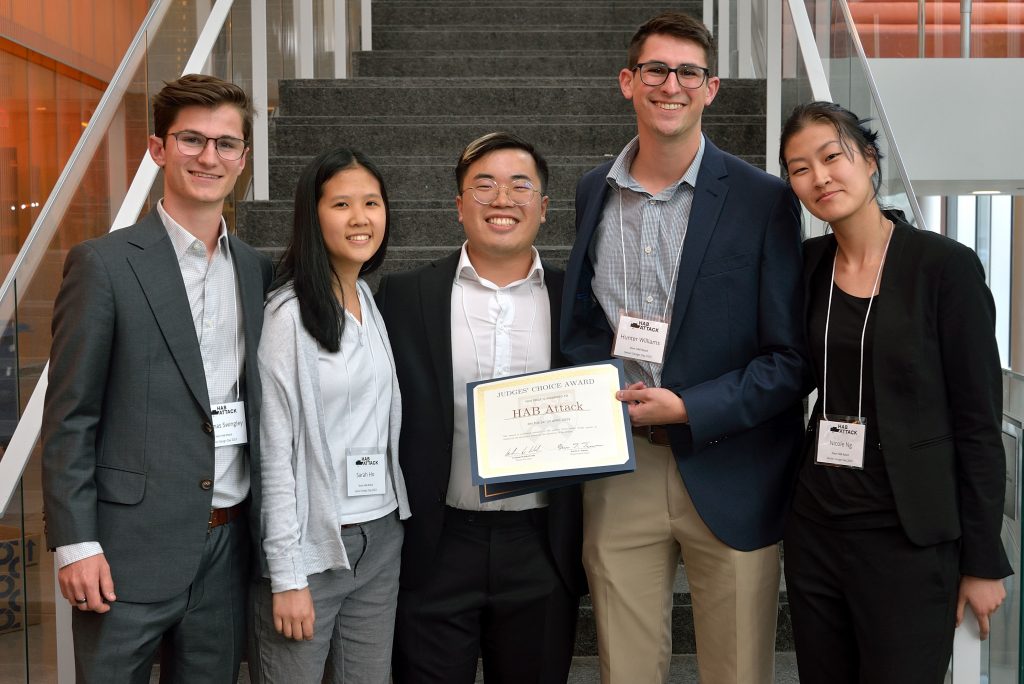
Team HAB Attack, comprised of Alex Choi, Nicole Ng, Sarah Ho, Thomas Swingley, and Hunter Williams, were winners of the of the Judges’ Choice Award for excellence based on the discretion of the judges.
HAB Attack is a portable craft designed to aid stakeholders in preventing and treating HABs through ultrasonic irradiation and surface aeration. It is intended for use by water treatment centers, state park rangers, and wildlife conservation programs. HAB Attack allows users the novel ability to prevent and treat local HABs. If deployed consistently through the spring and summer, the expert electrical and labor cost of running and maintaining our product is under $2,000.00 annually.
Team OneShoe, comprised of Sarah Musa, Jake Russo, Miranda Stern, and Jessica Sui were winners of the William K. Gemmill Memorial Prize for outstanding creativity.
OneShoe is a shoe made for children primarily between the ages 1 – 3 that will grow with the child’s foot from 3.75 – 5” in length, 1.25 – 1.5” in width, and 1.25 – 1.5” in height. The outer sole of this shoe will be made from thermoplastic polyurethane (TPU): a highly-manufacturable polymer with exceptional elasticity and robustness.
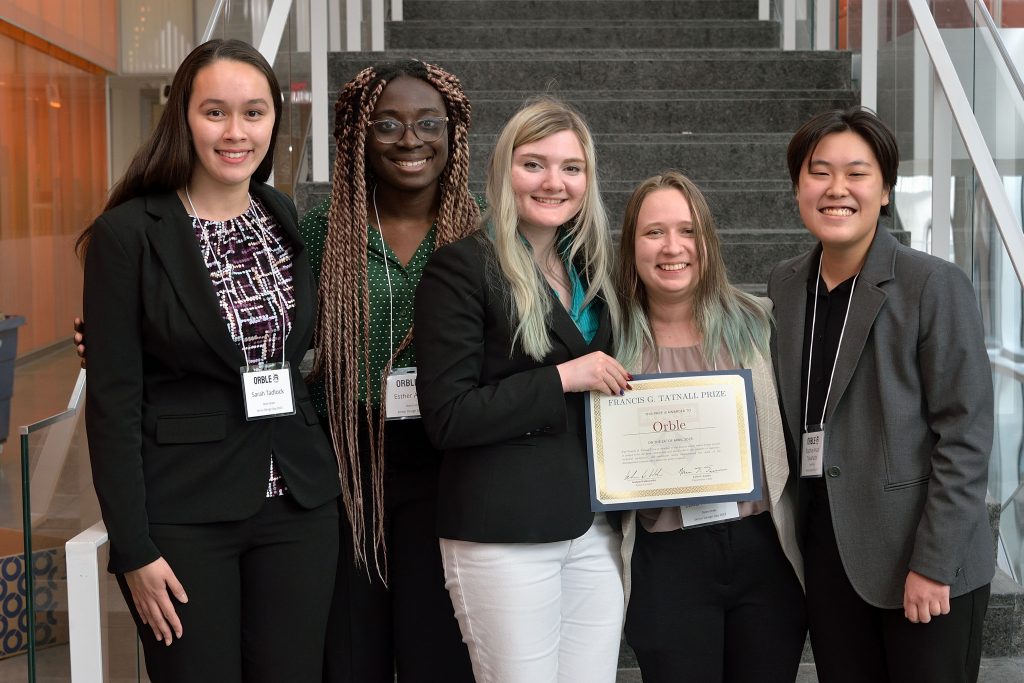
Team Orble, comprised of Esther Amao, Sophia Anzai Takahashi, Lada Korotaeva, Nastassja Kuznetsova, and Sarah Tadlock, were winners of the Francis G. Tatnall Prize for an outstanding project showing ingenuity, proficiency and usefulness.
Orble, is a commercial automated bubble tea machine that can be installed anywhere a waste line, water, and electrical services exist. The machine is compact with a footprint of just 1x1m and height of 1.7m, requires only three hours of service a week, and serves drinks in 3-5 minutes. Orble conducts the full bubble tea production process including (1) storing and cooking boba pearls, (2) mixing drinks from various powdered ingredients, (3) dispensing the cup, (4) dispensing the boba pearls, mixed liquid and ice into the cup, and (5) heat sealing the lid.
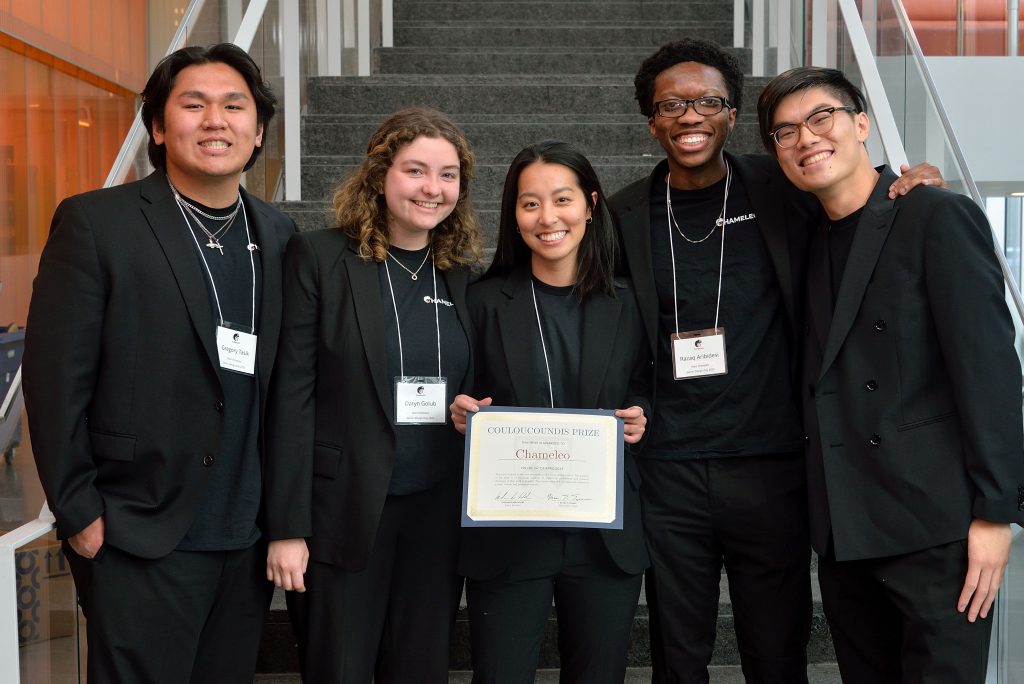
Team Chameleo, comprised of Terence Lin, Sharon Kuo, Daryn Golub, Razaq Aribidesi, and Gregory Tasik were winners of the John Couloucoundis Prize for the best senior design presentation.
Amateur and advanced painters alike desire a way to replicate colors in their work that they may see online, in other pieces, or in physical objects and landscapes. However, mixing paint to achieve a desired color is often difficult and time consuming, regardless of skill level. Chameleo is an exploratory paint dispensing tool that improves color matching and mixing processes in various art industries, providing a solution that is efficient, accurate, and user-friendly. Chameleo is compact and portable (10” x 10” x 18” in size) and can be easily operated by end users open to implementing new tools into their artwork. Chameleo will leverage color theory algorithms and high-precision dispensing technology to ensure accurate color dispensing.
2022 Winners
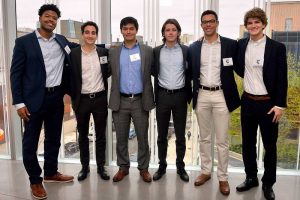 Team Capwell, comprised of Justin Hegar, Walter Hubsch, Andrew Lane, Lucien Peach, Tomas Pinilla, and Niko Simpkins, were winners of the of the Judges’ Choice Award for excellence based on the discretion of the judges, for their abandoned oil and gas well methane flaring system.
Team Capwell, comprised of Justin Hegar, Walter Hubsch, Andrew Lane, Lucien Peach, Tomas Pinilla, and Niko Simpkins, were winners of the of the Judges’ Choice Award for excellence based on the discretion of the judges, for their abandoned oil and gas well methane flaring system.
5-8% of Pennsylvania’s methane emissions, an aggressive greenhouse gas and a safety risk for nearby residents, emanates from these abandoned wells. Furthermore, this is not just a Pennsylvania problem; similar levels of methane emissions from abandoned wells exist in oil and gas rich areas across the US and globally. The current solution is to backfill the well with cement, which is prohibitively expensive and destructive to the surrounding environment. Capwell is a capture, compression, and efficient flaring solution that can reduce greenhouse emissions up to 80 times at a tenth of the cost of cementing. The system can be installed quickly with no need for heavy equipment and minimal workforce.
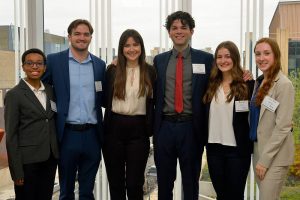 Team AlignMED, comprised of Andreas Alexandrou, Sharon Baranov, Keanan Dols, Brianna Messam, Meghan Moran, and Olivia Unger were winners of the William K. Gemmill Memorial Prize for outstanding creativity, for their development of a next-generation flotation mattress that aims to reduce pressure injury (bedsore) incidence.
Team AlignMED, comprised of Andreas Alexandrou, Sharon Baranov, Keanan Dols, Brianna Messam, Meghan Moran, and Olivia Unger were winners of the William K. Gemmill Memorial Prize for outstanding creativity, for their development of a next-generation flotation mattress that aims to reduce pressure injury (bedsore) incidence.
Hospital patients, particularly the infirm and eldery, lack the strength or cognizance to regularly reposition themselves when lying down. The resulting prolonged contact pressure obstructs blood flow near their skin and often leads to deep wounds in their underlying soft tissue. The problem is extensive and costly. Over 3 million individuals develop a pressure sore each year, manual repositioning of patients, the most widely employed solution, increases caretaker workload by 50%, and prevention and treatment of bedsores costs $10 billion annually in the US. AlignMED employs small-scale air cells, each individually monitored and controlled, to modulate and reduce pressure points. The system employs cells of a variety of sizes with more densely-packed cells located at contact points most susceptible to pressure injuries. Moreover, the system is constructed using materials and methods that allow for sanitary use in a hospital environment.
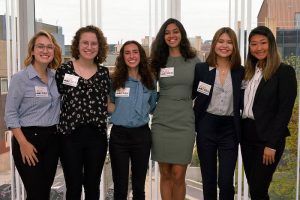 Team ORITREK, comprised of Natalie Aziz, Sophia Bowe, Natasha Dilamani, Daphnie Friedman, Joah Kim, and Celestina Saven, were winners of the Francis G. Tatnall Prize for an outstanding project showing ingenuity, proficiency and usefulness, for their design and manufacturing of a novel folding snowshoe with detachable crampon
Team ORITREK, comprised of Natalie Aziz, Sophia Bowe, Natasha Dilamani, Daphnie Friedman, Joah Kim, and Celestina Saven, were winners of the Francis G. Tatnall Prize for an outstanding project showing ingenuity, proficiency and usefulness, for their design and manufacturing of a novel folding snowshoe with detachable crampon
First responders to casual hikers in winter environments often encounter transitions between snow and ice, which require time-consuming and difficult swaps between snowshoes that float above snow and spiked crampons that dig into ice. Moreover, snowshoes are large and cumbersome to carry when not in use. ORITREK solves both of these problems. The deck of the snowshoe folds compactly for easy transport and stowage when traversing ice. The team then devised novel coupling mechanism that allows the user to quickly engage and disengage the crampon from the snowshoe even when wearing gloves. This attachment mechanism includes a pivot point near the ball of the foot to support a natural walking gait.
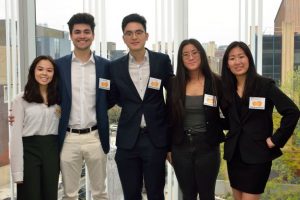
Team BeatBlocks, comprised of Isaac Blinn, Tessa Fang, Jun Park, Hannah Wang, and Lauren Yu, were winners of the John Couloucoundis Prize for the best senior design presentation, for their contributions to childhood musical education.
Early music education positively impacts a child’s development throughout their life, but educational opportunities and engagement are dwindling due to shrinking school budgets. There is a push to develop engrossing and age-appropriate music education activities that are broadly and financially accessible. The team worked with an educator from Illinois to improve upon an impactful educational activity she had developed. In this activity, students stack Lego-like blocks that contain pitch and note duration labels and the teacher plays the resulting melody. This activity format constrains learning to the school environment and requires a musician. BeatBlocks is a music education toy that packages the concept in a single, low-cost, and fully-integrated system. Children snap pitch and note duration blocks into a sled and the system loops the resulting melody. Sound and light are employed to provide rich feedback and the educational experience is augmented through app integration, extensibility, and gamification. The concept liberates this fun and impactful early childhood music activity from the classroom and allows it to be taken anywhere.
2021 Winners
2021 Winners:
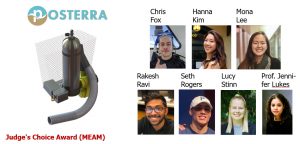 Team Posterra, comprised of Chris Fox, Hanna Kim, Mona Lee, Rakesh Ravi, Seth Rogers, and Lucille Stinn, were winners of the of the Judges’ Choice Award for excellence based on the discretion of the judges.
Team Posterra, comprised of Chris Fox, Hanna Kim, Mona Lee, Rakesh Ravi, Seth Rogers, and Lucille Stinn, were winners of the of the Judges’ Choice Award for excellence based on the discretion of the judges.
Posterra is a handheld underwater device that aims to be the ultimate assistant to SCUBA divers participating in clean-up dives. It accomplishes this goal by allowing divers to safely remove solid waste at depths up to 10 meters within the sublittoral zone of the ocean, while also providing an effective storage solution for the collected waste. The device, designed and manufactured by the team, functions using a venturi pump that interfaces with a hose and mesh containment unit attached to the diver’s air tank. Once the diver is underwater, the device’s suction force can easily be turned on and off by flipping a single switch. The venturi pump directs the waste through the hose into the containment unit on the back of the SCUBA diver without threatening the diver’s safety and maintaining the necessary degrees of freedom required during swimming. An additional quick release mechanism allows the diver to quickly remove the entire device in the event of an emergency by removing a pin on the back of the SCUBA tank. Currently, there are no commercially available devices that provide aid during the process of clean-up dives. Existing technology only targets solid waste within the top 1-2 meters of the water column. The team has designed and built the device to operate in the conditions of underwater clean up dives while prioritizing diver safety and mobility. A prototype has been robustly tested within a submerged environment to ensure maximum waterproofing and suction capabilities.
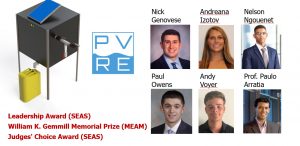
Team PVRE, comprised of Nicholas Genovese, Andreana Izotov, Nelson Ngouenet, Paul Owens, and Andres Voyer, were winners of the William K. Gemmill Memorial Prize for outstanding creativity.
Water borne illnesses are a great health risk across the globe. Roughly 2.5 billion people still do not have access to safe water sanitation and over 3.5 million people die each year from water-related disease. These deaths are more prevalent in developing nations, where inadequate water purification is unable to eliminate bacteria from the water supply. Team PVRE’s goal is to create a cost-efficient, low-maintenance device that allows countries to have accessible and easy methods of water purification for implementation in local water storage locations. Ghana is a developing nation that suffers from a dangerously high quantity of water borne illnesses, with 25% of all child deaths under the age of 5 due to diarrhea, and 80% of all diseases caused by unsafe water. Based on discussions with stakeholders in Ghana, Team PVRE has a better understanding of the needs of the community. Team PVRE has designed a self-sustaining, long term, low maintenance water purification and filtration system to implement at the exit of communal storage tanks in developing communities. Their system relies on solar generated energy which is stored in a battery and used to power an ultraviolet germicidal lamp. The water is filtered through a sediment spindown filter and passes through a chamber that contains the ultraviolet light, deactivating any bacteria or protozoa within the water. This project will culminate in sending the PVRE system to Kumasi, Ghana, where it will be implemented to provide clean drinking water.
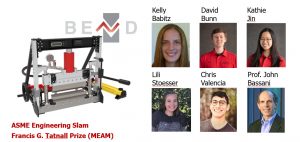
Team BEND, comprised of Kelly Babitz, David Bunn, Kathie Jin, Lilian Stoesser, and Christopher Valencia, were winners of the Francis G. Tatnall Prize for an outstanding project showing ingenuity, proficiency and usefulness.
Makers and engineers often integrate bent sheet metal parts into their designs to achieve complex geometry without excessive material removal. Yet, small shops and educational spaces often lack the tools to help engineers create cheap, accurate parts. BEND is a precise, reliable, compact, and low-cost sheet metal bending machine, suited for the needs of academia and makerspaces. A hydraulically actuated system, this machine allows users to bend aluminum and steel sheet metal up to 12” in bend length and at thicknesses up to 0.25”. Users would line up their sheet metal using the manual backstop positioning system and actuate an electric pump to create their parts using air bending tooling. BEND also comes with a lookup table to aid the user in accounting for spring back in their bends, resulting in accurate and predictable results. Total time to complete a bend is less than 1 minute, about 6 times faster than manual tools. Final items produced on BEND have tolerances of +/- 2° on bend angle, and +/- 0.050” on bend location. Due to high loads in the system, all components were designed with safety factors and analyzed using FEA to ensure reliability and safety. The team conducted extensive safety tests to verify these calculations before proceeding into validation tests for locational and angular accuracy and material thickness feasibility. BEND allows students and makers to produce custom made sheet metal parts with angular and locational tolerances comparable to industry standards, with only a fraction of the cost and time.
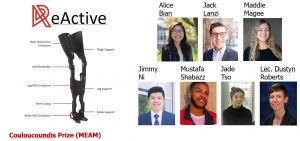
Team ReActive, comprised of Alice Bian, Jack Lanzi, Madison Magee, Jimmy Ni, Mustafa Shabazz, and Huen-Yee Tso, were winners of the John Couloucoundis Prize for the best senior design presentation.
Despite dramatic strides in gait and balance clinic technologies, only 35% of physical therapy patients fully adhere to their plans of care when home. Patients struggle with a lack of positive feedback, recalling instructions from their therapist, and brace discomfort during extended wear. The core of ReActive R1 is a Digital Light Synthesis 3D printed leg brace which seamlessly integrates three inertial measurement units and associated electronics. Using 3D printing, ReActive R1 is able to provide a custom brace while going directly from clinician measurements to CAD – skipping the cost and time associated with leg casting. These custom braces, keeping brace junctures within 2” of joints, have been shown to improve walking results. Measurement protocol and design has been validated to minimize brace slippage, the major source of patient discomfort. Through fall testing and finite element analysis, ReActive R1 is designed to survive everyday impacts. ReActive R1’s sensors provide ankle and knee flexion within 3° of markerless motion capture, the leading standard in gait mapping research. These data are compiled into the ReActive App, which provides patients a portal to communicate with their physical therapist and track their progress. With all day battery power, users can charge ReActive R1 overnight for easy integration with their current habits. The ReActive R1 brace brings a revolution to remote rehabilitation with gait insights powered by a custom KAFO brace.
2020 Winners
2020 Winners:
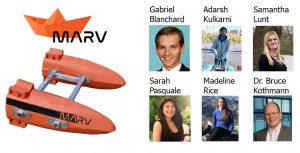
Team MARV, comprised of Gabriel Blanchard, Adarsh Kulkarni, Samantha Lunt, Sarah Pasquale, and Madeline Rice, were winners of the Francis G. Tatnall Prize for an outstanding project showing ingenuity, proficiency and usefulness.
NASA is planning to land the first woman and next man on the Moon by 2024. The goal of the program is to achieve a long-term presence on the Moon, establish a moon economy, and provide a stepping-stone to send humans to Mars. Launching humans into space continues to be a risky endeavor and safety systems are paramount. In the event of a rocket failure during launch, the crew capsule will jettison from the main rocket and land in the ocean. The crew must then board an inflatable lifeboat. There is risk that a crew member is separated from the main group during this disembarkment. The Maritime Autonomous Rescue Vehicle (MARV) is an autonomous watercraft that may be used to accurately locate the stranded crewmember and provide them with water, first aid supplies, and communication equipment while search and rescue first attend to the crew on the lifeboat. MARV was designed with a catamaran hull for stability and payload capacity and can autonomously navigate safely within reach of the stranded astronaut. The system achieves autonomous navigation using three redundant and progressively more accurate sensing techniques. As NASA intends to drop MARV from the air, the team designed the craft to operate under any landing orientation, survive up to a 15-foot fall, and demonstrate water-tightness when encountering significant impact forces.
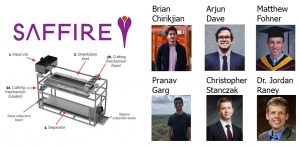
Team SAFFIRE, comprised of Arjun Dave, Brian Chirikjian, Chris Stanczak, Matthew Fohner, and Pranav Garg, were winners of the William K. Gemmill Memorial Prize for outstanding creativity.
Saffron is used as a spice and colorant in many popular culinary dishes, cosmetics, and perfumes. At $5000 per kilogram, it is the most expensive spice in the world! This cost is a result of its labor-intensive production process. The source of the spice is the three small stigma of each saffron flower, which are currently plucked by hand. The process requires almost 200 person-hours per kilogram of spice. Domestic production of the spice would provide an important rotational and cash crop for farmers, but the high cost of human labor in the United States is prohibitive. SAFFIRE was designed to lower the cost of processing. Saffron flowers that have been cut in the field are placed into the machine. A vibrating array of troughs aligns the flowers, the petals of the flowers and stigma are cut from the stems, and then the mixture is sorted using a blower and conveyer system. The SAFFIRE system was designed to yield a 95% stigma recovery rate to enable profitable domestic saffron production.
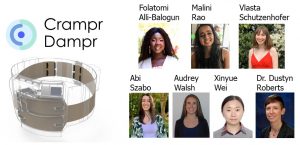
Team Crampr Dampr, comprised of Folatomi Alli-Balogun, Malini Rao, Vlasta Schutzenhofer, Abigail Szabo, Audrey Walsh, and Xinyue Wei, were winners of the John Couloucoundis Prize for the best senior design presentation.
Menstrual pain, caused by contractions of the uterus during monthly menstruation, affects roughly 50% of people who menstruate. 10% report pain so severe that they are unable to carry out normal daily activities. Common forms of pain management such as nonsteroidal anti-inflammatory drugs, heating, massage, and exercise come with limitations due to health restrictions, cost, and conflict with everyday routines. Crampr Dampr is a discreet device (only 1.25 inches thick) that the user wears around their abdomen like a belt and provides both heat and massage. Unlike existing heating pads and massage devices that are bulky and need to be plugged into a receptacle, Crampr Dampr is diminutive enough be worn unnoticeable under clothing and provides freedom of movement via a rechargeable battery source. Silicone-coated nichrome wires distribute the heat across the abdomen and a quiet pump and custom air bladder system produces massage-like pressures. The team performed research on over 100 users to determine efficacious and safe temperature and pressure envelopes. The team also prioritized the safety and comfort of the design. Crampr Dampr employs a quick release system in case of malfunction and engineered fabrics were integrated to wick moisture away from the wearer’s skin.
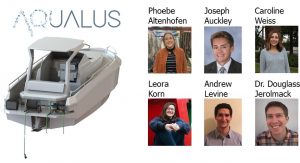
Team Aqualus, comprised of Phoebe Altenhofen, Joseph Auckley, Leora Korn, Andrew Levine, and Caroline Weiss, were winners of the Judges’ Choice Award for excellence based on the discretion of the judges.
Microplastics, plastic particles with sizes less than 5 millimeters, have been detected across the world’s waterways. This pollution poses a serious threat to marine life and aquatic ecosystems. Informed and impactful policy can mitigate the hazards of these pollutants providing a robust understanding of their magnitude and dispersion. Current microplastics sampling methods are inefficient and imprecise – they rely on labor intensive practices that yield error prone and incomparable data sets. Enter Aqualus! This boat-mounted microplastics collection device processes massive amounts of water (up to 500 liters per sample) through a stack of filters to isolate microplastics ranging in size from 10 to 500 microns. The solution features a hose, reel, and pump system to allow collection of samples up to depths of 50 feet. Moreover, the system is semiautonomous and low-cost. Aqualus provides researchers with an efficient, accessible, and accurate method to track the health of our aquatic ecosystems.
2019 Winners
2019 Winners:
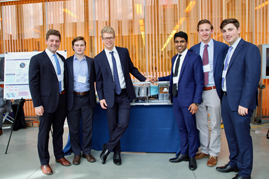 Team Aerate, comprised of Spencer Collins, Jake Fine, Ashwin Kishen, Yann Pfitzer, Connor Sendel, and Sam Weintraub, were winners of the Francis G. Tatnall Prize for an outstanding project showing ingenuity, proficiency and usefulness.
Team Aerate, comprised of Spencer Collins, Jake Fine, Ashwin Kishen, Yann Pfitzer, Connor Sendel, and Sam Weintraub, were winners of the Francis G. Tatnall Prize for an outstanding project showing ingenuity, proficiency and usefulness.
The number of air conditioners is expected to triple by 2050, which will result in unsustainable demands on the energy grid and even more perilous carbon dioxide emissions. The majority of this growth will occur in humid regions that are unsuitable for existing, highly efficient evaporation-based air conditioners. To address this problem, the team developed a 2/3 scale evaporative air conditioner that utilizes nascent and efficient membrane dehumidification on the input stream and evaporative cooling on the output stream. The development of the Aerate system required a deep understanding of heat and mass transfer, detailed characterization of dehumidification membrane performance characteristics, vacuum pump analysis, advanced manufacturing, and a series of increasingly capable prototypes.
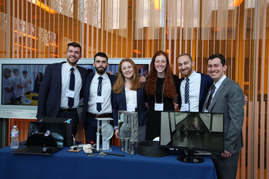 Team TerraNova, comprised of Jonah Arnheim, Claire Brundage, Allison Grey, Dylan Hawkes, Gregory Robinov, and Raphael Van Hoffelen, were winners of the William K. Gemmill Memorial Prize for outstanding creativity.
Team TerraNova, comprised of Jonah Arnheim, Claire Brundage, Allison Grey, Dylan Hawkes, Gregory Robinov, and Raphael Van Hoffelen, were winners of the William K. Gemmill Memorial Prize for outstanding creativity.
Tunnels on the Moon may provide insight into its geologic history, access to valuable minerals, and safe harbor for long-term missions. Skylights above these tunnels, the result of tunnel roof collapses, provide a means of entry. However, traditional wheeled rovers would get stuck in these rubble-filled entryways. To address this problem, the team devised and manufactured the TerraNova rover, which features a novel cam and follower jumping mechanism to surmount these obstacles. The team performed aggressive strength and weight analysis of the system’s structural components in order to deliver a robot capable of traversing difficult terrain while carrying impactful sensor systems deep into lunar tunnels.
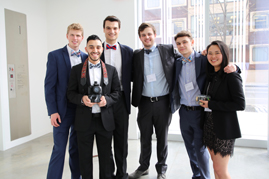 Team SharpShooter, comprised of Bennet Caraher, Paul Flores, Karina Gunadi, Miltos Kitsios, Matt Oslin, and Jake Welde, were winners of the John Couloucoundis Prize for the best senior design presentation.
Team SharpShooter, comprised of Bennet Caraher, Paul Flores, Karina Gunadi, Miltos Kitsios, Matt Oslin, and Jake Welde, were winners of the John Couloucoundis Prize for the best senior design presentation.
Photographers today often use long shutter speeds to take high dynamic range, low light, or high depth of field pictures. Camera movement during these shots leads to unsuitable image blur. Currently, long-exposure photographs require the use of bulky equipment such as tripods and gimbals. The significant setup time required for these devices often leads to lost photographic opportunities. SharpShooter is a compact, portable camera accessory that can be attached to any conventional camera and provides stability approaching that of a tripod – all with near-zero setup time. The system utilizes reaction wheels, much like those used to change the attitude of satellites, to counteract external disturbances and provide crisp long-exposure images. The development of SharpShooter required significant stakeholder testing, a deep understanding of the mathematics behind image sharpness, thermal analysis, a lightning-fast control algorithm, and design for assembly.
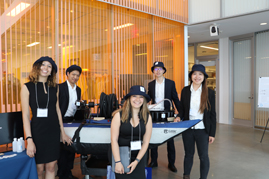 Team S.S. MAPR, comprised of Sherry (Xiaoyi) Chen, Frank (Fangyi) Fan, Quinn Wu, Eunice Lee, Vanessa Howell, and Mia Mansour, were winners of the Judges’ Choice Award for excellence based on the discretion of the judges.
Team S.S. MAPR, comprised of Sherry (Xiaoyi) Chen, Frank (Fangyi) Fan, Quinn Wu, Eunice Lee, Vanessa Howell, and Mia Mansour, were winners of the Judges’ Choice Award for excellence based on the discretion of the judges.
River ecosystems, which are often a source of drinking water, are constantly threatened by the discharge of harmful substances from industry and farming. Current water quality monitoring methods require significant labor costs and capital investment, which leads to infrequent and low-resolution measurements. Water authorities need a method to efficiently and economically track water quality across rivers and at multiple depths. Enter S.S. MAPR! S.S. MAPR is a low cost (approx. $3000) watercraft that is capable of collecting water samples and performing in situ water quality measurements to a 50-foot depth. The system is easily transported by one to two persons and collects measurements autonomously at waypoints specified by the user. The system promises to shorten the time between data collection from 1 year to 6 days while reducing operating costs by up to 80%.
2018 Winners
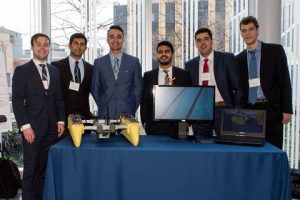 Team SeaSearcher, comprised of Alex Andalia, Nikhil Chari, Jay Fleischer, Thomas Macchio, Xavier Perraudin, and Eric Quesada, were winners of the Francis G. Tatnall Prize Winner for an outstanding project showing ingenuity, proficiency and usefulness.
Team SeaSearcher, comprised of Alex Andalia, Nikhil Chari, Jay Fleischer, Thomas Macchio, Xavier Perraudin, and Eric Quesada, were winners of the Francis G. Tatnall Prize Winner for an outstanding project showing ingenuity, proficiency and usefulness.
SeaSeacher is an autonomous, reverse-bow catamaran for coral reef data collection. Coral reefs have a large economic impact on coastal communities and existing coral reef data collection is unnecessarily time consuming and expensive. Working in conjunction with ecologists, team SeaSearcher devised a highly portable and stable vessel that can be remotely instructed to map a coral reef with 50 cm accuracy and cover an area of 40,000 square meters within a 6-hour time period. The project required a deep understanding of fluids, system dynamics, controls, and electronics.
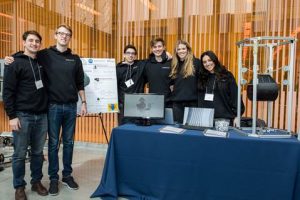 Team Daedalus, comprised of Rome Arnold, Eugenia Bejar, Pele Collins, Max Newberger, Michael Pearson, and Rosalind Shinkle, were winners of the William K. Gemmill Memorial Prize for outstanding creativity.
Team Daedalus, comprised of Rome Arnold, Eugenia Bejar, Pele Collins, Max Newberger, Michael Pearson, and Rosalind Shinkle, were winners of the William K. Gemmill Memorial Prize for outstanding creativity.
Currently, space vehicle recovery parachutes open in discrete stages (disreefing stages). These discrete stages result in large peak impulse forces that require overdesigned and costly vehicle support structures. Working in conjunction with SpaceX and NASA engineers, team Daedalus devised a novel disreefing system that utilizes a passive capstan device and active friction brake system to continuously control the disreefing process. Ultimately, the device promises to reduce vehicle launch costs by lowering peak impulse forces during vehicle descent. The development of the Daedalus system required an intricate understanding of strength of materials, controls, and friction.
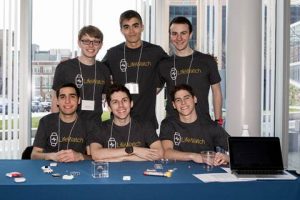 Team EpiPenn, comprised of Ben Bernstein, Spencer Fox, Alex Garcia, Reed Ginsberg, Daniel Orol, and Jacob Snipes, were winners of the Couloucoundis Prize for the best senior design presentation.
Team EpiPenn, comprised of Ben Bernstein, Spencer Fox, Alex Garcia, Reed Ginsberg, Daniel Orol, and Jacob Snipes, were winners of the Couloucoundis Prize for the best senior design presentation.
LifeWatch is a wearable epinephrine auto-injector in a watch-like form factor. The device was designed as an easy-to-remember and easy-to-carry solution for the 1 in 50 Americans that suffer from anaphylaxis. The team worked aggressively to miniaturize their injection device without sacrificing robustness and reliability. Notably, the team devised a novel, 2-stage needle release and injection subsystem, custom syringe capsule, and labyrinth seal. Their design process included finite-element analysis of the structural components, computational fluid dynamics to ensure reliable delivery of epinephrine, and design for manufacturability.
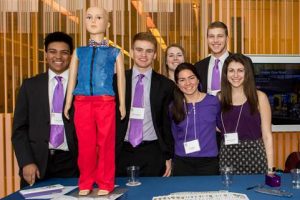 Team HUGS, comprised of Becky Abramowitz, Matt Caltabiano, Anna Estep, Erica Higa, John Killoran, and Sean Trahan, were winners of the Judges Choice Award for excellence based on the discretion of the judges.
Team HUGS, comprised of Becky Abramowitz, Matt Caltabiano, Anna Estep, Erica Higa, John Killoran, and Sean Trahan, were winners of the Judges Choice Award for excellence based on the discretion of the judges.
One in 68 children have an Autism Spectrum Disorder (ASD), which is often accompanied by sensory sensitivities that lead to panic and stress. Deep Pressure Therapy, akin to the feeling of being hugged, has been shown to calm children with ASD. The Helpful Undergarment for Getting Rid of Stress (HUGS) is a customizable, inflatable undergarment controlled by a mobile application that proactively provides deep pressure to children aged four to six in response to biometric and environmental signs of overstimulation. The HUGS team analyzed the thermodynamics of perspiration and cooling to ensure device comfort, investigated the mechanical performance of a multitude of fabrics to achieve the boundary conditions necessary for application of deep pressure, and validated the performance of their system using an array of force sensors and human comfort testing.
2017 Winners
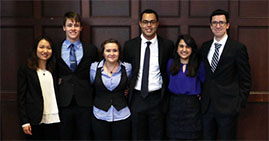 Team This is … Spinal Map, comprised of Elyse Chase, Kevin Crossley, Sterling Graham, Nancy Linxuan Fang, Marshall Pritt, and Alysha Singh, were winners of the Francis G. Tatnall Prize Winner for an outstanding project showing ingenuity, proficiency and usefulness.
Team This is … Spinal Map, comprised of Elyse Chase, Kevin Crossley, Sterling Graham, Nancy Linxuan Fang, Marshall Pritt, and Alysha Singh, were winners of the Francis G. Tatnall Prize Winner for an outstanding project showing ingenuity, proficiency and usefulness.
Backster is a wearable for tracking and visual feedback of the torso during exercise and rehabilitation. Backster’s six absolute orientation sensors communicate real-time to a computer model of the user’s torso allowing the user to correct their form on-the-fly.
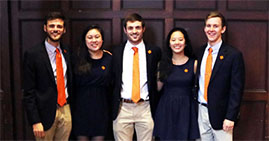 Team Volonomic, comprised of Patrick Boyle, Courtney Kobata, Cheryl Liu, Daniel Shanks, and Aaron Weinstein, were winners of the William K. Gemmill Memorial Prize for outstanding creativity.
Team Volonomic, comprised of Patrick Boyle, Courtney Kobata, Cheryl Liu, Daniel Shanks, and Aaron Weinstein, were winners of the William K. Gemmill Memorial Prize for outstanding creativity.
VI is the first fully-actuated, 6 degree-of-freedom, multi-rotor aerial vehicle capable of stable, controllable flight in all directions and orientations. The dexterity of VI allows the craft to operate in spaces inaccessible to existing aerial vehicles, notably quadrotors.
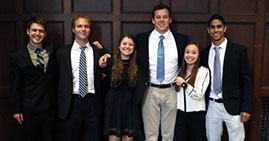 Team Chillers, comprised of Ashley Berg, Nick Demes, Sam Gaardsmoe, Dan Harris, Drew Lilley, and Rachel Schwimmer, were winners of the Couloucoundis Prize for the best senior design presentation.
Team Chillers, comprised of Ashley Berg, Nick Demes, Sam Gaardsmoe, Dan Harris, Drew Lilley, and Rachel Schwimmer, were winners of the Couloucoundis Prize for the best senior design presentation.
Frio is a personal, wearable cooling device in a watch-like form factor. This low power device takes advantage of evaporative cooling and forced convection to provide 5 hours of cooling per charge.
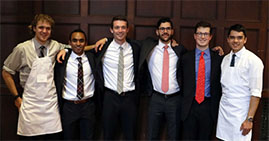 Team The Chefs, comprised of Sam Altland, Will Constan, Brian Dhingra, Anthony Faustini, Jasper Liu, and Jeremy Wright, were winners of the Judges Choice Award for excellence based on the discretion of the judges.
Team The Chefs, comprised of Sam Altland, Will Constan, Brian Dhingra, Anthony Faustini, Jasper Liu, and Jeremy Wright, were winners of the Judges Choice Award for excellence based on the discretion of the judges.
Automelette is an automated, self-contained, made-to-order omelette station for commercial dining establishments. The Automelette allows a user to select from six toppings and the standardization of the omelette cooking process yields consistency in taste and quality of the final product.
2016 Winners
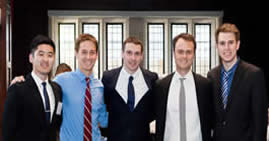 Justin Chang, Foster Collins, Aedhan Loomis, Andrew McGrath, and Mike Meigs, winners of the Francis G. Tatnall Prize Winner for an outstanding project showing ingenuity, proficiency and usefulness.
Justin Chang, Foster Collins, Aedhan Loomis, Andrew McGrath, and Mike Meigs, winners of the Francis G. Tatnall Prize Winner for an outstanding project showing ingenuity, proficiency and usefulness.
SCUBAssist is a semi-autonomous underwater vehicle that aims to be the ultimate recreational SCUBA diving assistant. The vehicle is capable of both scouting dive sites over tethered control and semi-autonomously following and recording video of a SCUBA diver during a dive. Finalist in the 2016 Intel Cornell Cup.
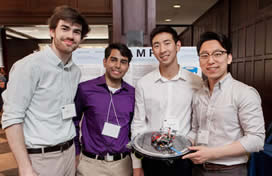 Golam Kibria, John Kim, Christian Wang and Tighe Costa, winners of the William K. Gemill Memorial Prize for outstanding creativity.
Golam Kibria, John Kim, Christian Wang and Tighe Costa, winners of the William K. Gemill Memorial Prize for outstanding creativity.
HAMR is a low-cost holonomic robot platform based on a unique drive mechanism that is simpler and more robust on uneven terrain than conventional omnidirectional systems, such as powered casters and omniwheels. By providing maneuverability for other robotic systems like manipulators or robot-human interfaces, HAMR can enable research and lower the cost barrier for consumer robotics. Finalist in the 2016 Intel Cornell Cup.
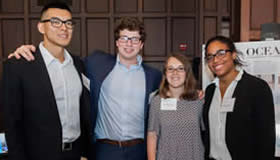 William Cheng, Sasha Klebnikov, Christina Springer, Chevonaé Walcott, winners of the Couloucoundis Prize for the best senior design presentation.
William Cheng, Sasha Klebnikov, Christina Springer, Chevonaé Walcott, winners of the Couloucoundis Prize for the best senior design presentation.
Team Oceanus has developed an autonomous system to provide for the fresh water demands of families in remote locations by directly integrating a Wave Energy Convertor (WEC) with a reverse osmosis desalination system. Our solution is a novel, compact system that uses springs to mechanically capture and modulate the rapidly varying pressure of ocean waves. Without such control, the lifetime of reverse osmosis membranes would be greatly reduce.
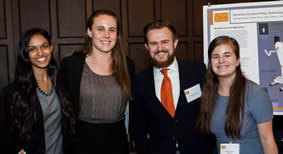 Jessica Hasson, Carder House, Sarah Lawson, Mihiri Rajapaksa, winners of the Judges Choice Award for excellence based on the discretion of the judges.
Jessica Hasson, Carder House, Sarah Lawson, Mihiri Rajapaksa, winners of the Judges Choice Award for excellence based on the discretion of the judges.
Team MoviFlex developed not only a low cost and energy-efficient, but also engaging stationary bike to address the rehabilitation needs of children afflicted with Cerebral Palsy in low resource communities. The estimated manufacturing cost of the MoviFlex bike is $500-1000, almost an order of magnitude cheaper than existing solutions.
2015 Winners
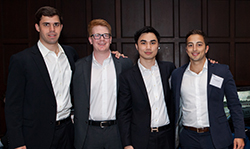 Bahram Banisadr, Mark Gallagher, Kristopher Li, Anthony Terracciano, winners of the Francis G. Tatnall Prize Winner for an outstanding project showing ingenuity, proficiency and usefulness.
Bahram Banisadr, Mark Gallagher, Kristopher Li, Anthony Terracciano, winners of the Francis G. Tatnall Prize Winner for an outstanding project showing ingenuity, proficiency and usefulness.
Mechanek was designed to withstand the intense forces present in a crash. Starting with simple static analysis, components were designed and then analyzed using finite element analysis as well as destructive mechanical testing. These tests guided material selection and design revision that resulted in a device manufactured to standards developed by racing governing bodies including FIA, SFI, and NASCAR. They also participated in the Cornell Cup.
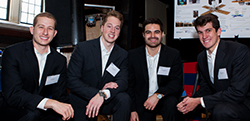 John Doyle, Manfred Reiche, Tommy Sutton, and John Whitman, winners of the William K. Gemill Memorial Prize for outstanding creativity.
John Doyle, Manfred Reiche, Tommy Sutton, and John Whitman, winners of the William K. Gemill Memorial Prize for outstanding creativity.
Turbox was designed to take advantage of the abundant wind energy in Sub-Saharan Africa, specifically intended for low-consumption power generation in remote, off-grid locations. Turbox is an inexpensive device that is easy to transport and can be assembled without tools or technological expertise.
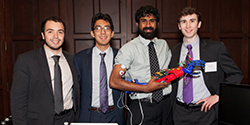 Adrian Lievano, Aadithya Prakash, Freddy Hernandez, Matthew Lisle, Steven Xing, winners of the Couloucoundis Prize for the best senior design presentation.
Adrian Lievano, Aadithya Prakash, Freddy Hernandez, Matthew Lisle, Steven Xing, winners of the Couloucoundis Prize for the best senior design presentation.
BionUX is a prosthetic arm with the ability to recreate touch for its users. Custom designed sensors at the fingertips collect pressure and vibration data which enables the arm to recreate these sensations by pressing into and vibrating on the skin through a haptic actuator. They also participated in the Cornell Cup.
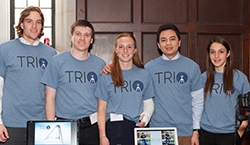 Greg Caso, Kevin Cruz, Davita Frankel-Bonacci, Clara Midgley, and Rob Ritchie, winners of the Judges Choice Award for excellence based on the discretion of the judges.
Greg Caso, Kevin Cruz, Davita Frankel-Bonacci, Clara Midgley, and Rob Ritchie, winners of the Judges Choice Award for excellence based on the discretion of the judges.
Trio is a reimagined tripod that can be set up quickly and simply. Trio has two activation levers that control a system of spring-loaded, toothed locks inside of all three legs. Trio can be set up in three steps, all in under 30 seconds.
2014 Winners
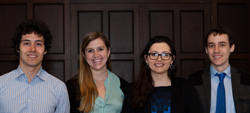 Sawyer Brooks, Emily Samuelson, Sebastian Schloesser and Cristina Sorice, winners of the Francis G. Tatnall Prize for an outstanding project showing ingenuity, proficiency and usefulness.
Sawyer Brooks, Emily Samuelson, Sebastian Schloesser and Cristina Sorice, winners of the Francis G. Tatnall Prize for an outstanding project showing ingenuity, proficiency and usefulness.
SPARC, or small-scale solar-powered automated oceanic research vessel and sensing platform, is a vessel whose capabilities include self-righting catamaran design, automated navigation via compass and GPS, and versatile sensor interface for data collection. Design is easily scalable in size to meet the needs of a variety of users. This team also participated in the Cornell Cup.
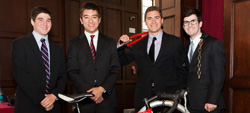 Alex Neier, Joe Hill, Joe Polin and Justin Starr, winners of the William K. Gemill Memorial Prize for outstanding creativity.
Alex Neier, Joe Hill, Joe Polin and Justin Starr, winners of the William K. Gemill Memorial Prize for outstanding creativity.
PubLock is an electromechanical, ground-mounted community bike lock network. Capabilities include extreme tamper resistance, modularity, scalability, and access via RFID and/or Bluetooth communication protocols.
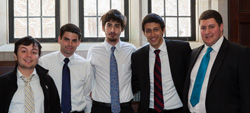 Jonathan Cousins, Rafi Pelles, Brandon Jennings, Jon Nino and Iason Stamatiadis, winners of the Couloucoundis Prize for best senior design presentation.
Jonathan Cousins, Rafi Pelles, Brandon Jennings, Jon Nino and Iason Stamatiadis, winners of the Couloucoundis Prize for best senior design presentation.
Persona is a bed-mounted robotic arm with three joints developed to assist a mute quadriplegic with daily tasks. Capabilities include direct control via internet-based interface, automated control for specific repetitive tasks, and replaceable end effecter.
 Keelen Collins, Kate Wessels, Sarah Martezian, Jon Law and Kristin Marra, winners of the Judges Choice Award for excellence based on the discretion of the judges.
Keelen Collins, Kate Wessels, Sarah Martezian, Jon Law and Kristin Marra, winners of the Judges Choice Award for excellence based on the discretion of the judges.
trueWheel is an automated electromechanical bicycle wheel truing system. Capabilities include wheel rim displacement sensing, automated spoke nipple manipulation and wheel rotation, and predictive programming for optimized wheel truing based on wheel rim displacement and inputs such as spoke number and spoke lacing pattern.
2013 Winners
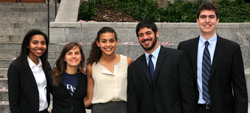 Lauren Davis, Michael Kofron, Stella Latscha, Gabrielle Merritt and Anthony Stroffolino, winners of the Tatnall Prize for an outstanding project showing ingenuity, proficiency and usefulness. They also won third place at the 2013 SEAS Senior Design Competition.
Lauren Davis, Michael Kofron, Stella Latscha, Gabrielle Merritt and Anthony Stroffolino, winners of the Tatnall Prize for an outstanding project showing ingenuity, proficiency and usefulness. They also won third place at the 2013 SEAS Senior Design Competition.
The H.E.R.A.L.D. (Hybrid Exploration Robot for Air and Land Deployment) is a search and rescue robot that combines a nimble snake form to travel through rubble with the surveillance capability of a quadrotor. H.E.R.A.L.D. operates in three modes: 1. all three robots operate independently; 2. the two snakes carry the quadrotor to save battery life; and 3. the quadrotor carries a single snake at a time over impassable obstacles. This novel system will be used by the Modular Robotics Laboratory as a research platform for computer vision, mapping, control and victim location.
 Jason Gui, Drew Karabinos, Jonathan Kern and R. Blake Winston, winners of the Gemmil Award for outstanding creativity. They also won first honorable mention at the 2013 SEAS Senior Design competition.
Jason Gui, Drew Karabinos, Jonathan Kern and R. Blake Winston, winners of the Gemmil Award for outstanding creativity. They also won first honorable mention at the 2013 SEAS Senior Design competition.
The inVigo Glasses were designed to provide a sleek, inexpensive, and reliable method to combat the problem of unintentional drowsiness. The inVigo Glasses monitor a user’s blinking patterns in order to accurately and reliably detect signs of drowsiness. Once the glasses detect that a user is dozing off, they send a digital signal to the user’s phone, ensuring the user regains his/her alertness before a potentially dangerous situation arises.
 Elizabeth Beattie, Nicholas McGill, Nicholas Parrotta and Nikolay Vladimirov, winners of the Judges Choice Award for excellence based on the discretion of the judges. They also won second place at the 2013 SEAS Senior Design Competition.
Elizabeth Beattie, Nicholas McGill, Nicholas Parrotta and Nikolay Vladimirov, winners of the Judges Choice Award for excellence based on the discretion of the judges. They also won second place at the 2013 SEAS Senior Design Competition.
TitanArm is an upper body exoskeleton capable of augmenting strength and mobility in occupational lifters, while offering improved physical therapy results for patients and doctors. The suit was designed and manufactured at Penn, and is powered by a brushed DC motor through a flexible cable drive. The system also takes position, velocity, and force measurements, and can stream that information to a control station or supervisor for data analytics.
2012 Winners
 Nicholas W. Bartlett, Neel Doshi, Nisan Lerea, Adam Libert, and Carlee Wagner, winners of the Gemmil Award for outstanding creativity.
Nicholas W. Bartlett, Neel Doshi, Nisan Lerea, Adam Libert, and Carlee Wagner, winners of the Gemmil Award for outstanding creativity.
Advisor: Dr. Jonathan P. Fiene
Waterjet cutting is a manufacturing process that uses a high velocity stream of water forced through a small orifice to cut through plastic, metal, stone, and many other materials. Existing water jet machines are large and expensive, limiting them to industrial settings. Their project, MEAM Waterjet, is a small-scale waterjet, making this technology available to universities and hobbyists.
 Annett Bordoley, Rikki Irwin, Viraj Kalyani, Craig G. McDonald and Dorsey E. Standish, winners of the Tatnall Prize for an outstanding project showing ingenuity, proficiency and usefulness. They also received Second Honorable Mention at the 2012 SEAS Senior Design Competition.
Annett Bordoley, Rikki Irwin, Viraj Kalyani, Craig G. McDonald and Dorsey E. Standish, winners of the Tatnall Prize for an outstanding project showing ingenuity, proficiency and usefulness. They also received Second Honorable Mention at the 2012 SEAS Senior Design Competition.
Sponsor: Dr. Vinay Nadkarni
Advisor: Dr. Katherine Kuchenbecker
Their project is entitled D1GIT: Automated, Temperature Calibrated Measurement of Capillary Refill Time. Because of the inconsistencies in the current method of manual capillary refill testing, the team set out to automate the process, collaborating throughout the year with doctors from the Children’s Hospital of Philadelphia. The result is D1GIT, a compact and lightweight device designed to read normal and temperature-corrected capillary refill time to the tenth of the second. At a manufacturing cost of under $100, the device has the potential to be sold commercially for use by doctors, EMTs, and nurses.
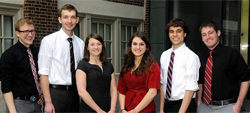 Sarah Clark, Sydney E. Jackopin, Jacob Orloff, Michael L. Posner and Michael Siegel, winners of the Couloucoundis Prize for the best presentation of a Senior Design project.
Sarah Clark, Sydney E. Jackopin, Jacob Orloff, Michael L. Posner and Michael Siegel, winners of the Couloucoundis Prize for the best presentation of a Senior Design project.
Advisor: Dr. Bruce Kothmann
Their project is entitled StoRC: Search to Rescue Craft. Unmanned aerial vehicles (UAVs) provide a way for taking pilots out of harm’s way during dangerous missions, either from weather or military threats. StoRC explores the application of autonomous flight and payload delivery on a model airplane. The system presented uses a UAV to deliver supplies to a target location via a parachute. The UAV’s guidance system uses GPS technology to autonomously navigate to a target location. Once on target, the system would combine data from its sensor package with a drop trajectory model to calculate a release point for its payload. After releasing its payload, the UAV would then autonomously flies back to its home base for human-controlled landing. Models of the UAV’s physical dynamics and the autonomous control scheme were created and used to develop initial parameters for the control code. By performing test flights and logging flight data, these models were validated and were used to build more complex autonomous behaviors. Stabilized flight, autonomous drop trajectory calculations with payload release, and autonomous navigation methods were all implemented and successfully tested, though full start to finish missions are still pending.
 Andrew N. Brown, Karan H. Desai, Andrew H. McGrath, Alfred “Hurst” Nuckols III and Grant P. Wilson, winners of the Best Poster Prize for the most effective poster/demonstration describing a superior project.
Andrew N. Brown, Karan H. Desai, Andrew H. McGrath, Alfred “Hurst” Nuckols III and Grant P. Wilson, winners of the Best Poster Prize for the most effective poster/demonstration describing a superior project.
Advisor: Dr. Andrew Jackson
Their project is entitled Hydraulic Drivetrain with Regenerative Braking. The Hydraulic Drivetrain with Regenerative Braking Team set out to demonstrate the ability to scale down hydraulic hybrid drivetrains for their use in passenger vehicles. The team tested this through replacing a go-kart’s drivetrain with a custom built hydraulic drivetrain with regenerative braking. Utilizing commonly available parts, the team was able to construct and analyze a hydraulic drive train on a scale even smaller than a passenger vehicle and assess its potential for commercialization.
2011 Winners
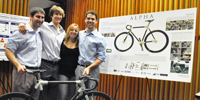 Evan Dvorak, Lucas Hartman, Geoffrey Johnson, Kathryn Rohacz and Katherine Savarise, winners of the Gemmil Award. They also came in First Place at the 2011 SEAS Senior Design Competition.
Evan Dvorak, Lucas Hartman, Geoffrey Johnson, Kathryn Rohacz and Katherine Savarise, winners of the Gemmil Award. They also came in First Place at the 2011 SEAS Senior Design Competition.
Advisor: Dr. Jonathan P. Fiene
The team set out to create a bicycle that would push the boundaries of integrated systems. The result is ALPHA, the first bicycle with a fully internal drivetrain including an electronically-controlled clutch allowing the rider to switch between fixed-gear and freewheeling configurations. All of the bike’s components, including a belt drive, brakes, and an onboard electronics suite, are housed inside the custom-machined frame and were fabricated entirely in-house.
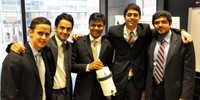 Tal Bar-Or, Gaurav Gupta, Juan Jacobus-Avila, Ishan Sehgal and Ritwik Lodhiya, winners of the Tatnall Prize. They also came in Third Place at the 2011 SEAS Senior Design Competition.
Tal Bar-Or, Gaurav Gupta, Juan Jacobus-Avila, Ishan Sehgal and Ritwik Lodhiya, winners of the Tatnall Prize. They also came in Third Place at the 2011 SEAS Senior Design Competition.
Advisor: Dr. Andrew Jackson
Their project is entitled the HydraVita – High-Speed Water Filtration System for Developing Countries. It is the first sterilization system to utilize a silver nanowire/carbon nanotube-coated cotton filter. This allows for higher speed and lower cost water sterilization than existing methods.
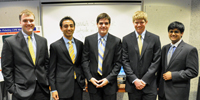 Michael Boyle, Nihar Dharamsey, Simon Healey, Nihar Naik and Andrew Stanley, winners of the Couloucoundis Prize. They also received First Honorable Mention at the 2011 SEAS Senior Design Competition.
Michael Boyle, Nihar Dharamsey, Simon Healey, Nihar Naik and Andrew Stanley, winners of the Couloucoundis Prize. They also received First Honorable Mention at the 2011 SEAS Senior Design Competition.
Advisor: Dr. Katherine J. Kuchenbecker
Their project is entitled the High-Fidelity Mannequin Chest for CPR Training. This device uses active control of pneumatic dampers to more accurately recreate the feel of a real human chest, while also providing force and position feedback to help users analyze their form as they learn CPR.
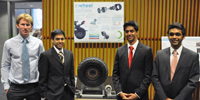 Rishi Agrawal, Tejus Goenka, Adhiraj Gupta, William Price and Misha Yerlick, winners of the Best Poster Prize.
Rishi Agrawal, Tejus Goenka, Adhiraj Gupta, William Price and Misha Yerlick, winners of the Best Poster Prize.
Advisor: Dr. Mark Yim
Their project is entitled the In-Wheel Electric Motor for an Electric Vehicle.
2010 Winners
 Tom Castner, Dale Yates-Berg, and Todd Tewksbury, winners of the Gemmil Award.
Tom Castner, Dale Yates-Berg, and Todd Tewksbury, winners of the Gemmil Award.
[2nd Place at SEAS 2010 Senior Design Competition]
Their project, Hybrid Rocket Motor, was designed and built to offer “simplicity, safety, good performance, comparatively cleaner environmental characteristics, and lower cost, particularly compared to solid propellant rockets.”
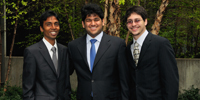 Anjay Kumar, Sudarshan Venu, and Jeremy Lautman, winners of the Tatnall Prize.
Anjay Kumar, Sudarshan Venu, and Jeremy Lautman, winners of the Tatnall Prize.
Their project, the Obese Patient Hospital Transport System aims to make a difference to the lives of healthcare workers, who are often at risk for injury when transporting patients.
 Alikhan Sapargalieyev, Andrew Tam, and Reed Lerner, winners of the Couloucoundis prize.
Alikhan Sapargalieyev, Andrew Tam, and Reed Lerner, winners of the Couloucoundis prize.
Their project, the Towne Hall Clock, was created to learn more about several aspects of mechanics, including mechanical power transmission, especially gearing; and to advance knowledge of control and mechatronics in a challenging and unconventional setting.
 Davesh Shah and Michael Shomin, winners of the Couloucoundis prize.
Davesh Shah and Michael Shomin, winners of the Couloucoundis prize.
Their project, the ROMPER Educational Robo-Kit, was developed to provide a robotics kit for educational purposes. A partnership was developed with the Free Library of Philadelphia to implement an innovative robot featuring omni-directional drive, an arm manipulator, as well as modular circuitry.
 Alex Berger, Zach Zwicker, Jamie Greenberg, and David Dahl, winners of the Best Poster Prize.
Alex Berger, Zach Zwicker, Jamie Greenberg, and David Dahl, winners of the Best Poster Prize.
Their project is entitled the Highest Strength-to-Weight Aircraft (SAE).
2009 Winners
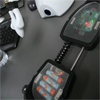 Jonathan Bohren and Alexander Rattner, winners of the Gemmil Award.
Jonathan Bohren and Alexander Rattner, winners of the Gemmil Award.
Their project, the FatPoodle foot controller (bottom right in the photo), is a four-degrees-of-freedom adjustable device that is used like a computer mouse.
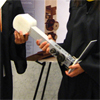 Carolyn Fu and Vinny Kumar, winners of the Tatnall Prize.
Carolyn Fu and Vinny Kumar, winners of the Tatnall Prize.
Their project, the Electronics Free Gait Automation is a design for a purely mechanical, unpowered system for automating walking that can be used in above-the- knee prostheses, orthoses, and exoskeletons.
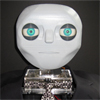 Kate Chovanetz, Matthew MacMillan and Travis VanSchoyck, winners of the Couloucoundis prize.
Kate Chovanetz, Matthew MacMillan and Travis VanSchoyck, winners of the Couloucoundis prize.
Their project, the Rapidly Orienting Green Eyed Robot, better known as R.O.G.E.R., was created to promote human-robot interaction. With a set of cameras located in the eyes, ROGER has the ability to track human faces and respond to different actions by displaying various emotions.
2008 Winners
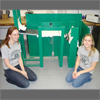 Elyse Newman and Francesca Lattanzio, winners of the Gemmil Award.
Elyse Newman and Francesca Lattanzio, winners of the Gemmil Award.
Their project, TRASH-E, is a smart trash can that automatically sorts recyclables. This allows for a single receptacle that promotes green waste disposal, even taking into account human error and the lack of a separate recycling bin.
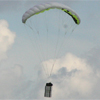 Warren Jackson, winner of the Tatnall Prize.
Warren Jackson, winner of the Tatnall Prize.
His project, the Radiosonde Recovery, is a robot that determines a safe landing spot for a radiosonde (used in weather detection) and adjusts the parachute in such a way as to steer it there. This project also won the school-wide Senior Design Competition for 2008.
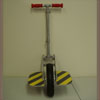 Esteban Argudo, Brian Cohen, Matthew Ford and Kimberly Gallant and Patricia Leskiw, winners of the Couloucoundis prize.
Esteban Argudo, Brian Cohen, Matthew Ford and Kimberly Gallant and Patricia Leskiw, winners of the Couloucoundis prize.
The project designed by Argudo, Cohen, Ford and Gallant is the One Wheel Human Transporter.
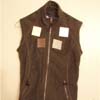 The Project Designed by Leskiw is the Human Heat Driven Thermoelectric Generator, a vest worn that generates electricity through the body heat of the wearer.
The Project Designed by Leskiw is the Human Heat Driven Thermoelectric Generator, a vest worn that generates electricity through the body heat of the wearer.
2007 Winners
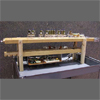 Peter Brueckner, Kristen Condello, Michael Dugan and William Jelliffe, winners of the Gemmil Award.
Peter Brueckner, Kristen Condello, Michael Dugan and William Jelliffe, winners of the Gemmil Award.
Their project was named Ravi-Bot, and is an autonomous robotic sitar that can improvise music in the classical Hindustani style. The name is derived from the world’s most famous sitar player, Ravir Shankar. Ravi-bot was also featured in Artbots, an exhibit at the Esther Klein Art Gallery. This project also won first prize in the school-wide Penn Engineering Design competition.
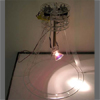 Erik Trautman, winner of the Tatnall Prize.
Erik Trautman, winner of the Tatnall Prize.
His project was Robotic Lighting.
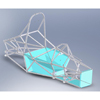 Wy-Men Loh, winner of the Couloucoundis prize.
Wy-Men Loh, winner of the Couloucoundis prize.
This project was named Chassis Design for Battery Electric Vehicle.
Undergraduate Program:
Staff Contact:
Katie Knorr
Academic Coordinator for Undergraduate Programs
229 Towne Building
Phone: 215-898-4825
Email: kknorr@seas.upenn.edu

